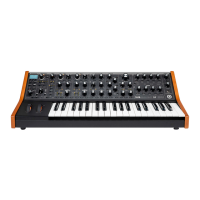9
OVERVIEW AND FEATURES
The Sub 37 is a 2-note paraphonic analog synthesizer, built in the tradition of classic Moog
synthesizers. It is housed in a rugged black steel chassis with aluminum extrusion, and finished with
classic wood sidepieces. Your new Sub 37 starts with a high-quality, 37-note keyboard that has both
velocity sensitivity and aftertouch. This offers a highly expressive and musical playing experience.
All critical performance and sound design features are provided directly on the front panel, which is
equipped with 40 knobs and 74 switches. This makes creating, saving, and retrieving your own sounds
fast and effortless. Each knob and switch on your Sub 37 also sends and receives MIDI, making the Sub
37 a completely automatable analog synthesizer and powerful MIDI controller.
Unlike its smaller sibling, the Sub 37 has the ability to play more than one note at a time via a new
function called DUO MODE. This allows each of the Sub 37’s highly stable oscillators to play completely
independent pitches from one another. Voices are then processed through a single, classic 20Hz-20kHz
Moog Ladder Filter. The Filter section has a dedicated selector switch for filter slope, and control for
MultiDrive. When combined with the new Mixer Feedback function, a vast array of sound creation
possibilities become available.
The Sub 37 boasts 2 fully assignable modulation busses, 2 DAHDSR looping envelopes, and a
powerful arpeggiator with a paraphonic 64-note step sequencer. Each of these sections has a
dedicated SYNC switch, which allows you to easily determine which features are synchronized
to MIDI, internal clock, or running free.
With its extensive feature set and one-knob-per-function design, the Sub 37 is the ideal instrument for
any synthesist, sound designer, or performing musician.
BASICS OF SOUND
If you’re new to the world of music synthesis, it helps to have at least a rudimentary understanding of
music and acoustics. Even if you know this stuff like the back of your hand, it never hurts to approach it
from a fresh perspective.
Several qualities distinguish one musical sound from another, including pitch, loudness, duration, and
timbre. Being able to manipulate those qualities allows you to turn raw sound into music.
Simply put, sound occurs when a vibrating object causes the air around it to vibrate. That object could
be a guitar string, a loudspeaker, or anything capable of rapid movement. An individual vibration is
called a wave or cycle, and the rate of vibration is called frequency. Frequency determines the sound’s
pitch, and pitch determines how high or how low you perceive the sound on a musical scale. Frequency
is measured in Hertz (abbreviated Hz), which describes the actual number of times that something
vibrates every second. One thousand cycles per second is called a kilohertz (kHz).
amplitude
wavelength
low frequency high frequency

